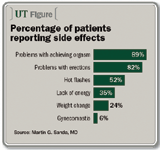Article
Androgen therapy's side effects are common, severe
San Antonio--The adverse side effects of hormone therapy in prostate cancer patients may be more severe and manifest sooner than many might believe, according to two separate studies presented here at the 2005 AUA annual meeting.

Martin G. Sanda, MD, director of the Prostate Care Center at Beth Israel Deaconess Medical Center and Harvard Medical School in Boston, looked at neoadjuvant hormone therapy prior to radiation therapy to find that losses of vitality and sexual function that now can be attributed directly to hormone therapy began within the first 2 months of initiating such treatment. Adverse effects may be substantial enough to raise benefit-outcome questions.
In a second study, Christopher Ryan, MD, found that hormone therapy is associated with significant bone loss that appears early in treatment.
Dr. Sanda presented early findings from the PROST-QA Consortium, a multicenter study of prostate cancer patient-reported outcomes funded by the National Cancer Institute. A total of 559 prostate cancer patients responded to computer-assisted telephone interviews using formal instruments. The interviews were conducted before hormone treatments were initiated and at 2 months from start of treatment. Among patients who received NHT, this allowed side effects of NHT to be measured before definitive intervention (primarily radiation) began.
Although NHT side effects were anticipated, the suddenness of their appearance and their extent were not. Within 2 months after starting NHT, more than half (52%) reported hot flashes; 6% reported gynecomastia; 35% reported a lack of energy; 24% reported weight change; 82% reported problems with erections; and 89% reported problems with achieving orgasm.
Unexpected findings
"Two things were unexpected. One was how early they [side effects] appeared and two was how common they were," Dr. Sanda told Urology Times.
"It is widely recognized that neoadjuvant hormone therapy can improve the effectiveness of radiation treatments. What hasn't been well characterized is the quality-of-life impact of neoadjuvant hormone treatments. These findings suggest that the quality-of-life effects of the therapy are substantial and clinically significant.
"As a consequence of these findings, I think radiation therapists are faced with an obligation to offer hormone therapy, but at the same time, to recognize that there is a lot of uncertainty as to which patients really need it," he added.
Dr. Sanda noted that this study was one of the few to isolate side effects specifically attributable to the NHT component of pr-ostate cancer therapy. He said a number of studies have examined post-treatment side effects, but these were usually conducted after patients had undergone definitive radiotherapy, making it impossible to determine which effects should be attributed to hormone therapy.
Effects on bone
In the study led by Dr. Ryan, assistant professor of medicine (hematology/medical oncology) at the Oregon Health and Science University, Portland, he and colleagues acquired bone mineral density readings at the femoral neck, hip, and spine of 120 prostate cancer patients without bone metastases who had entered a multi-institutional study of androgen deprivation therapy plus zoledronic acid (Zometa) or placebo. All patients had been treated with androgen deprivation for less than a year. The median treatment period was 3 months. Significant bone loss was noted at all three locations and was associated with the duration of treatment.
"Up to two-thirds of patients receiving androgen deprivation for less than 12 months had either osteopenia or osteoporosis as defined by T-scores used for women," Dr. Ryan told Urology Times.
The women's scale was used because standards of T-score deviations for men have yet to be determined by consensus, he explained. He also noted that a significant portion of the osteopenia and osteoporosis found might be attributed to aging. The mean age of patients in the cohort was 72 years.
















